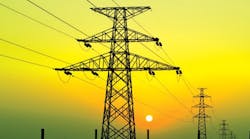Right-sizing the grid can reduce blackout risk, according to an analysis in Chaos: An Interdisciplinary Journal of Nonlinear Science.
North America currently depends on three mega grids, which are often run on the edge of capacity using outdated equipment, says David Newman, a physicist at the University of Alaska.
If the grid is already near its critical point, even a small disruption from a downed power line could cause the entire network to collapse.
To avoid these mass outages, researchers questioned whether the grid has an optimal size, one that can share power efficiently but prevent enormous blackouts.
They based their analysis on the Western United States grid, which has more than 16,000 nodes (generators, substations, and transformers). The model compared one 1,000-bus grid with ten 100-bus networks and then assessed how well the grids shared electricity in response to virtual outages.
"We found that for the best tradeoff between providing backup power and blackout risk, the optimal size was 500 to 700 nodes," Newman says.
Implementing regional or local grids, as opposed to a handful of large networks, will improve power quality and lower costs.
"In smaller grids, the blackouts are easier to fix because utilities can call for help from surrounding regions. Overall, small grid blackouts have a lower cost to society," Newman says. "If we reduce the number of connected pieces, we can reduce the societal cost of failures."


